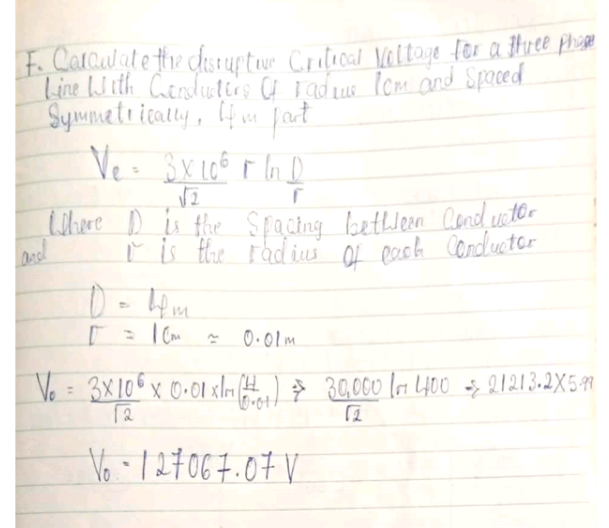- Calculate the disruptive critical voltage for a three phase line with conductor of radius 1cm and spaced symmetrically, 4m apart

Vc = (3 × 10⁶)/√2 • r × inD/r
where D is the spacing Conductor
and r is the radius of each conductor
D = 4m, r = 1cm ≈ 0.01m
Vo = (3 × 10⁶)/√2 • 0.01 × in(4/0.01)
30,000/√2in400 = 21213.2×5.99
Vo = 127067.07v
2. State three (3) characteristics of fuse element
I. Low melting point e.g tin
II. High conductivity e.g copper
C. Low cost e.g lead
- Define circuit breaker and state four types of circuit breaker
Circuit breaker is a piece of equipment which can make or break a circuit manually or by remote control under normal condition
B. State four types of circuit breaker
I. Oil circuit breaker
B. Gas circuit breaker
III. Miniature circuit breaker
IV. Air circuit breaker
C. State four (4) differences between fuse and circuit breaker
Fuse only work in one time and the element will be replaced
Circuit breaker work over and over again
Fuse time operation is about 0.02secs
Circuit breaker time operation is about 0.5secs
Fuse element can be tempered with when replacing
Circuit breaker can’t be tempered with
Fuse element are always replaced after operation
Circuit breaker don’t need replacement
- List four types of insulators and sketch any one(1)
1) Pin type insulator
2) Suspension type insulator
3) shackle insulator
Write short note on insulating material
Insulating materials are the material which do not allow electric energy to pass through them. They’re also used on electric poles for supporting and separating the conductor on the pole.
Examples of insulating material
I. Dry wood
II. Glass
III. Porcelain
Explain the difference between feeders, distributor and service mains
I. Feeder: is a device that serve as a protection for the transformer and distribution line.
II. Distribution mains: This is the transmission line that comes out of the transformer usually on low tension poles and carry a voltage between 220v – 414v
III. Service mains: This is the mains which is used to tap from the distribution mains to the end users.
- Define protective relay and draw a typical relay circuit
PROTECTIVE RELAY: is a system used in protecting an electric circuit
B) List and briefly explain four (4) requirement for power system protection.
I. Reliable, II. Stable, III. It must be timely, IV. It must be selective
I. Reliable: The protection system must provide it function when required to avoid damage of equipment, life and property
II. Stable: The protection system must not react to fault in neighbouring zone and shall not react to non fault situation
III. It must be timely: The rate at which protecting system will react to fault must be fast as possible in other to stabilise the overall power system and to reduce the damage of life and property
IV. It must be selective: only the affected point of the power system will be disconnected
C) State the purpose of protection system
I. To protect equipment
II. To protect against overload
III. To improve system stability
IV. To restore number of direction
V. To protect life and property
VI. To separate faulty section from power supply
D) List four (4) types of protection by object
I. Line protection
II. Transformer protection
III. Generator protection
IV. Earth protection
